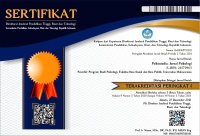Application of Developmental, Individual Differences, Relation-Based (DIR / Floortime) in Children with Developmental Disorders of the Neurological System and Brain
Abstract
This study aims to determine the effectiveness of the application of Developmental, Individual, Relation-Based (DIR / Floortime) based therapy in children who experience disorders related to the neurological system and brain, such as autism and attention deficit disorder and hyperactivity. The application of this intervention is based on 3 basic principles, namely (1) developmental tasks, (2) differences in the neurological processes of each individual, and (3) affective relationships between parents / therapists and children. This systematic literature review was conducted in 7 journals based on predetermined inclusion and exclusion criteria. The results of the literature review show that the DIR / Floortime intervention is an intervention that can improve the communication ability of children with neurodevelopmental and brain disorders, especially autism. Parents are more adaptable in developing children's abilities according to their level of development. This intervention is also an ideal alternative intervention for the lower middle class so as not to spend too much special money to see professionals to get regular therapy.
Penelitian ini bertujuan untuk mengetahui efektivitas penerapan terapi berbasis Developmental, Individual, Relation-Based (DIR/Floortime) pada anak-anak yang mengalami gangguan terkait sistem neurologis dan otak, seperti autis dan gangguan pemusatan perhatian dan hiperaktif. Penerapan intervensi ini berbasis pada 3 prinsip dasar, yaitu (1) tugas perkembangan, (2) perbedaan proses neurologis masing-masing individu, dan (3) hubungan afektif antara orang tua/terapis dengan anak. Ulasan tinjauan Pustaka sistematis ini dilakukan pada 7 jurnal berdasarkan kriteria inklusi dan eksklusi yang telah ditetapkan sebelumnya. Hasil ulasan literatur menunjukkan bahwa intervensi DIR/Floortime merupakan intervensi yang dapat meningkatkan kemampuan berkomunikasi anak dengan gangguan perkembangan saraf dan otak, khususnya autism. Orang tua lebih bisa beradaptasi dalam mengembangkan kemampuan anak sesuai dengan level perkembangannya. Intervensi ini juga merupakan alternatif intervensi yang cukup ideal bagi masyarakat kelas ekonomi menengah ke bawah agar tidak mengeluarkan biaya khusus terlalu banyak untuk menemui tenaga profesional demi mendapatkan terapi secara rutin.
Keywords
Full Text:
FULL TEXTReferences
Aali, S., & AminYazdi, S. A. (2017). Developing a Family-Based Floor Time Therapy and evaluation its effectiveness on the developmental profile of children with interactive disorders (anxiety and depression). International Journal of Pediatrics, 5(4). https://doi.org/10.22038/ijp.2017.22412.1879
Baker, B. L., McIntyre, L. L., Blacher, J., Crnic, K., Edelbrock, C., & Low, C. (2003). Pre-school children with and without developmental delay: Behaviour problems and parenting stress over time. Journal of Intellectual Disability Research, 47(4–5). https://doi.org/10.1046/j.1365-2788.2003.00484.x
Boshoff, K., Bowen, H., Paton, H., Cameron-Smith, S., Graetz, S., Young, A., & Lane, K. (2020). Child development outcomes of DIR/Floortime TM-based programs: a systematic review. Canadian Journal of Occupational Therapy, 87(2), 153–164.
Britto, P. R., Lye, S. J., Proulx, K., Yousafzai, A. K., Matthews, S. G., Vaivada, T., Perez-Escamilla, R., Rao, N., Ip, P., & Fernald, L. C. H. (2017). Early Childhood Development Interventions Review Group, for the Lancet Early Childhood Development Series Steering Committee. Nurturing care: promoting early childhood development. Lancet, 389(10064), 91–102.
Deb, S. (Shoumi), Retzer, A., Roy, M., Acharya, R., Limbu, B., & Roy, A. (2020). The effectiveness of parent training for children with autism spectrum disorder: a systematic review and meta-analyses. BMC Psychiatry, 20(1). https://doi.org/10.1186/s12888-020-02973-7
Faradina, N. (2016). Penerimaan diri pada orang tua yang memiliki anak berkebutuhan khusus. Psikoborneo: Jurnal Ilmiah Psikologi, 4(1).
Firnady, D. A., & Boediman, L. M. (2020). Floortime Approach to Increase Communication Skills for Children With Autism Spectrum Disorder and Intellectual Impairment. 3rd International Conference on Intervention and Applied Psychology (ICIAP 2019) and the 4th Universitas Indonesia Psychology Symposium for Undergraduate Research (UIPSUR 2019), 81–93.
Germain-Dillon, C. S., & Peters, S. (2021). Combining DIRFloortine and sensory integration for children with ASD. AOTA Continuing Education Article, 1–9.
Greenspan, S. I., Wieder, S., & Simons, R. (1998). The child with special needs: Encouraging intellectual and emotional growth. Addison-Wesley/Addison Wesley Longman.
Harnowo, P. A. (2013). Jumlah anak berkebutuhan khusus di Indonesia diperkirakan 4, 2 juta. Detik Health.
Karst, J. S., & van Hecke, A. V. (2012). Parent and Family Impact of Autism Spectrum Disorders: A Review and Proposed Model for Intervention Evaluation. In Clinical Child and Family Psychology Review (Vol. 15, Issue 3). https://doi.org/10.1007/s10567-012-0119-6
Kirana, E., Atmodiwirjo, E. T., & Basaria, D. (2019). Penerapan DIR Floortime Pada Anak dengan Autism Spectrum Disorder Untuk Meningkatkan Kemampuan Sosial. Psibernetika, 11(2).
Liao, S. T., Hwang, Y. S., Chen, Y. J., Lee, P., Chen, S. J., & Lin, L. Y. (2014). Home-based DIR/FloortimeTM intervention program for preschool children with autism spectrum disorders: Preliminary findings. Physical and Occupational Therapy in Pediatrics, 34(4). https://doi.org/10.3109/01942638.2014.918074
Loomes, R., Hull, L., & Mandy, W. P. L. (2017). What Is the Male-to-Female Ratio in Autism Spectrum Disorder? A Systematic Review and Meta-Analysis. In Journal of the American Academy of Child and Adolescent Psychiatry (Vol. 56, Issue 6). https://doi.org/10.1016/j.jaac.2017.03.013
M. Salman, A. (2016). Using DIR- Floor time based program to promote attachment behaviors in children with Autism Spectrum Disorders. IOSR Journal of Humanities and Social Science, 21(09). https://doi.org/10.9790/0837-2109111121
Marrus, N., & Hall, L. (2017). Intellectual Disability and Language Disorder. In Child and Adolescent Psychiatric Clinics of North America (Vol. 26, Issue 3). https://doi.org/10.1016/j.chc.2017.03.001
Marzali, A. (2016). Writing Literature Review. Journal of Ethnosia, 1(02), 27–36.
Mercer, J. (2017). Examining DIR/FloortimeTM as a Treatment for Children With Autism Spectrum Disorders: A Review of Research and Theory. Research on Social Work Practice, 27(5). https://doi.org/10.1177/1049731515583062
Nasution, A., Lubis, A. P., & Siddik, M. (2021). PENERAPAN M-LEARNING DENGAN METODE ABA DAN GLENN DOMAN BAGI ANAK BERKEBUTUHAN KHUSUS. JOURNAL OF SCIENCE AND SOCIAL RESEARCH, 4(3), 365–369.
Pajareya, K., & Nopmaneejumruslers, K. (2012). A one-year prospective follow-up study of a DIR/FloortimeTM parent training intervention for preschool children with autistic spectrum disorders. Journal of the Medical Association of Thailand, 95(9), 1184.
Panda, M. R., Nizamie, S. H., Pandey, P., & Kumar, V. (2019). A Case Study: Indian Ragas Adjunct to Floor Time Therapy for of a Child with Autism.
Papafragou, A. (2018). Pragmatic development. In Language learning and development (Vol. 14, Issue 3, pp. 167–169). Taylor & Francis.
Pradini, N. A. (2015). Metode Floor Time Terhadap Penambahan Kosakata Anak Autis di SLB. Jurnal Pendidikan Khusus, 7(4).
Ryan, J. B., Hughes, E. M., Katsiyannis, A., McDaniel, M., & Sprinkle, C. (2011). based educational practices for students with autism spectrum disorders. Teaching Exceptional Children, 43(3), 56–64.
Sealy, J., & Glovinsky, I. P. (2016). Strengthening the reflective functioning capacities of parents who have a child with a neurodevelopmental disability through a brief, relationship-focused intervention. Infant Mental Health Journal, 37(2). https://doi.org/10.1002/imhj.21557
Solomon, R., Necheles, J., Ferch, C., & Bruckman, D. (2007). Pilot study of a parent training program for young children with autism: The PLAY Project Home Consultation program. Autism, 11(3). https://doi.org/10.1177/1362361307076842
Theule, J., Wiener, J., Tannock, R., & Jenkins, J. M. (2013). Parenting Stress in Families of Children With ADHD: A Meta-Analysis. Journal of Emotional and Behavioral Disorders, 21(1). https://doi.org/10.1177/1063426610387433
Thompson, S., Hiebert-Murphy, D., & Trute, B. (2013). Parental perceptions of family adjustment in childhood developmental disabilities. Journal of Intellectual Disabilities, 17(1). https://doi.org/10.1177/1744629512472618
Tilmont Pittala, E., Saint-Georges-Chaumet, Y., Favrot, C., Tanet, A., Cohen, D., & Saint-Georges, C. (2018). Clinical outcomes of interactive, intensive and individual (3i) play therapy for children with ASD: a two-year follow-up study. BMC Pediatrics, 18(1), 1–13.
Wieder, S. (2017). The power of symbolic play in emotional development through the DIR lens. In Topics in Language Disorders (Vol. 37, Issue 3). https://doi.org/10.1097/TLD.0000000000000126
Yuwapoom, W., Nopmaneejumruslers, K., Jiawiwatkul, A., & Kleebpung, N. (2017). A Study of the Holistic Approach to Child Development According to the DIR/Floortime Concept: Banlat Hospital, Phetchaburi. International Journal of Child Development and Mental Health, 5(1), 43–54.
Zipper, R., Baine, S. D., Genizi, J., Maoz, H., Levy, N. S., & Levy, A. P. (2017). Developmental progression of intellectual disability, autism, and epilepsy in a child with an IQSEC2 gene mutation. Clinical Case Reports, 5(10). https://doi.org/10.1002/ccr3.1139
DOI: http://dx.doi.org/10.30872/psikostudia.v12i1.9270
Refbacks
- There are currently no refbacks.
Copyright (c) 2023 Psikostudia : Jurnal Psikologi

This work is licensed under a Creative Commons Attribution-ShareAlike 4.0 International License.
Psikostudia: Jurnal Psikologi is indexed by :
PSIKOSTUDIA: Jurnal Psikologi Published by Faculty of Social and Political Siences, University of Mulawarman, Samarinda, East Kalimantan and This work is licensed under a Creative Commons Attribution-ShareAlike 4.0 International License.
_________________________________________
PSIKOSTUDIA: Jurnal Psikologi
Department of Psychology
Faculty of Social and Political Siences, University of Mulawarman
Jl. Muara Muntai Kampus Gn. Kelua Samarinda 75411
Phone: +62 813 35350368
E-Mail: psikostudia@fisip.unmul.ac.id




















